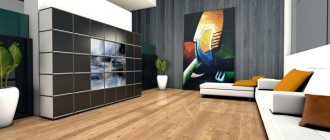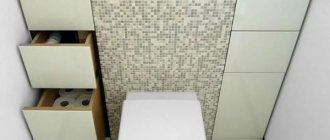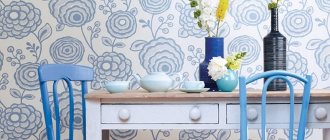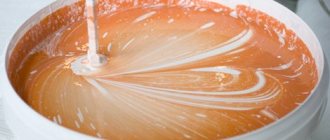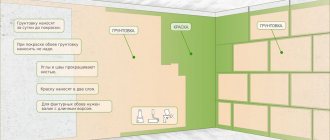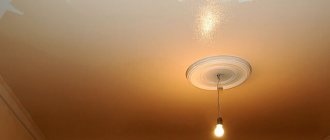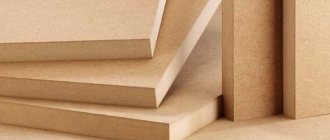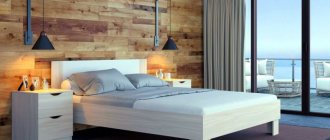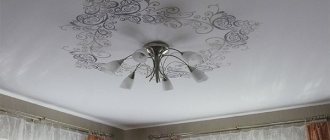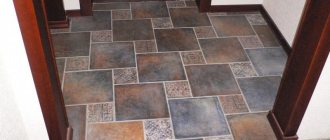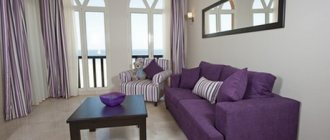Home renovation is a complex and important issue; everyone wants to get a result that will please the eye for a long time. The modern market offers a large number of materials for wall decoration. Painting and wallpapering remain the most popular. Both types have their pros and cons, which should be considered before deciding to paint the walls and wallpaper. The features of each will be discussed in detail below.
Paint or wallpaper: choosing the best
To decide whether to wallpaper or paint the walls, which would be better in a particular situation, the owner of the room must think through some points in advance. The following nuances need to be taken into account:
- How much money from the family budget will be allocated for finishing;
- Will a designer be involved in creating the design?
- They will carry out the work with their own hands, or turn to professionals for services;
- The service life of the coating that is desirable to obtain;
- What is the base of the walls in the room, what interior elements will be present on the surface.
Everyone decides for themselves what is best for them: wallpaper or painting the walls in their apartment. But some nuances of the capabilities and features of the room dictate what to prefer.
Everyone decides for themselves what is best for them: wallpaper or painting the walls in their apartment.
Characteristics
To finally decide which is better: painting the walls or gluing wallpaper, you should compare the main characteristics of the materials.
- Durability. In general, each of the options has a fairly long service life, but many parameters influence the retention time of the qualities. So, painted areas fade faster in the sun, but paper wallpaper has the same drawback. At the same time, in hallways, paint retains its appearance longer than any wallpaper.
- Installation. Gluing roll materials is much easier than painting the surface. For cladding, a minimal set of tools is used, and non-woven varieties do not require the application of glue to the strips. Working with paint is much more difficult; streaks and unpainted fragments should not be allowed; at least two layers must be applied.
- Reliability. To obtain a reliable coating, it is better to use paint instead of wallpaper. This is due to the properties of the material and the installation method. The composition is firmly fixed to the surface; it is more difficult to damage the decorative layer of paint than wallpaper. But many coatings do not allow walls to breathe, which leads to mold and mildew.
- Price. What is cheaper: wallpapering or painting the walls? This question is probably of paramount importance. In fact, in terms of this parameter, both options are almost the same, given the equivalent product classes. Although inexpensive paper products for covering the walls in a room will cost less than the required amount of paint.
There are other parameters, but the ones listed are the main ones.
The improvement in the quality of water-based paints and the emergence of new types of wallpaper have revived the competition for consumers between these finishing materials. But what is better for interior decoration - wallpaper or water-based paint? If we look at the statistics, we can conclude that Russian citizens prefer to use wallpaper for residential premises, and in public and commercial establishments they much more often choose water-based painting. But these are just statistics, and now let’s look at what is better, wallpaper or painting the walls, in fact.
The variety of types of trellises on sale makes it difficult to determine the advantages of this type of finishing. To talk about the advantages of wallpaper, you first need to consider the general characteristics, and then the features of different types. Among the advantages
Wallpaper can be noted:
- lower surface requirements (we have already written about preparing walls for wallpaper);
- the presence of heat and sound insulation properties;
- environmental cleanliness;
- simple gluing technology;
- the appearance on sale of new wallpaper for painting and 3D images on trellises, which significantly increased the possibilities in terms of room design.
Among the main disadvantages
:
- low strength;
- service life up to 8 years (for vinyl and glass wallpaper - up to 20 years);
- difficult maintenance, even in the case of washable wallpaper;
- difficulties with joining the pattern on adjacent canvases.
Paper-based trellises
breathable and able to hide defects on the wall surface. They do not tolerate moisture and are very short-lived.
Non-woven wallpaper
They are characterized by high elasticity, which facilitates the gluing process, and good sound insulation. They have a translucent structure, which requires a uniform color of the walls, and cannot be washed with water.
Vinyl coverings
durable, resistant to moisture and do not fade in the sun. Service life - up to 20 years. In case of fire and intense heating, they can release toxic substances.
Glass wallpaper
the strongest and most durable. Easy to clean with water and detergents. They don't burn. Can only be used for subsequent painting.
Pros and cons of wallpaper
There is a wide variety of wallpaper. With their help, you can get not only different images, but also the texture of the coating. This makes it possible to choose canvases to suit any interior style. To choose an option, you need to understand the types of wallpaper.
You can choose canvases to suit any interior style.
Paper
The most budget-friendly type, it’s easy to choose a pattern for the interior due to the variety of options. However, such finishing will not last long; it is used only in rooms with a dry microclimate. Suitable for people who often like to renew their coverage.
The most budget-friendly type, it’s easy to choose a pattern for the interior due to the variety of options.
Non-woven
They have been in demand lately; they produce meter rolls, which requires less time to stick the canvases on the wall. The adhesive solution is applied to the wall itself, this simplifies the process.
The adhesive solution is applied to the wall itself, this simplifies the process.
Vinyl
Vinyl ones are great for the kitchen; they retain moisture, protecting the base from biological formations. The range of color solutions is varied.
Vinyl ones are great for the kitchen; they retain moisture, protecting the base from biological formations.
Fiberglass
Few owners of new buildings or other residential premises choose it because of the unusual coating. The canvases have many positive qualities: they are non-flammable, vapor-permeable, can withstand moisture, can be painted, and can be obtained with a textured coating.
Few owners of new buildings or other residential premises choose it because of the unusual coating.
Benefits of wallpaper
Wallpaper or wall paint, which is better is easier to decide if you understand the pros and cons of each. Wallpaper material has several important positive aspects:
- Gluing does not require the preparation of a perfectly leveled surface, especially for thick canvases;
- The products are safe for human health;
- You can easily choose the right look for any style of room;
- The vapor permeability of the coating creates a favorable indoor microclimate.
You can easily choose the right look for any style of room.
Flaws
Wallpaper is safe and can be used in children's rooms, but you need to take into account that it will be almost impossible to remove stains or other manifestations of a child's creativity. Even if washable linens were used. And this is definitely a minus. If cats and dogs live in the house, they can tear off such finishing.
If cats and dogs live in the house, they can tear off such finishing.
Features and benefits of painting
You can paint a brick, log, plywood or plasterboard wall. Acrylic paint applies evenly to both smooth and textured surfaces. Technologists do not recommend using painting in a new house - the foundation shrinks, causing the surface to become covered with cracks.
Before painting, it is important to plaster them thoroughly - all imperfections will be visible on a smooth surface. It is better to invite a specialist to perform such work.
The advantages of painting include:
- possibility of individual selection of colors;
- durability - acrylic paint will last 6-8 years;
- hygiene - the painted surface is easy to wash or wipe with a damp cloth;
- simple repairs - scuffs can be touched up;
- If animals live in the house, painted walls attract them less.
Gradient paint on the wall.
Connoisseurs of minimalism in the interior prefer to use paint and varnish. You can choose any color from the assortment of Russian or foreign manufacturers.
If you couldn’t find the right shade, you can experiment by mixing dyes of different tones.
Paint is indispensable if you need to update stucco decorations or other decorative elements. If the room is small, you can paint the walls, cabinets, and chairs with the same paint - this will make the room look larger.
Special paint and varnish coatings are used for different rooms. Glossy ones are practical in the kitchen or bathroom; in the living room or hallway, a finish with a velvety or satin texture looks better.
To prevent the walls from looking boring and monotonous, you can apply artistic painting or stencil designs to the surface.
Paint: pros and cons
Paint or wallpaper is a dilemma solved by comparing the pros and cons of each type. Therefore, the types of paints and varnishes for interior work will be described below.
Water-based preparations
They are characterized by quick drying and ease of application. There are subtypes that have a relief texture that can cover up minor imperfections in the base. Exposure to ultraviolet rays causes color fading.
They are characterized by quick drying and ease of application.
Water-dispersed
A coating that is resistant to water, mechanical stress and breathable is obtained. Suitable for rooms with high humidity. The product is produced in two colors - white, black; dyes are used to obtain the required shade. If the room is cold, the layer will begin to deform.
A coating that is resistant to water, mechanical stress and breathable is obtained.
Acrylic
The film-like coating is durable and elastic. Moisture-resistant properties and resistance to ultraviolet radiation make the composition popular. But the price is expensive.
The film-like coating is durable and elastic.
Latex
The layer will repel moisture and will be able to cover some surface defects. The drying process does not take much time and is easy to apply. Can be used for textured and smooth substrates.
The layer will repel moisture and will be able to cover some surface defects.
Silicone
The degree of coverage is the highest compared to other types, so they can cover up flaws. Moisture resistant, washable.
The degree of coverage is the highest compared to other types, so they can cover up flaws.
Benefits of paints
The preparatory stage requires priming and the application of antiseptic agents, which helps to eliminate biological formations in the future. Paints are easy to update and correct flaws. It is possible to wash the layer; pets are passive to such finishing.
Paints are easy to update and correct flaws.
Flaws
Carrying out such repairs requires special skills; professionals charge a lot of money for such a service. Strong mechanical shocks are dangerous for the coating; the paint may peel off. Decorative paints with a textured structure are expensive.
Carrying out such repairs requires special skills; professionals charge a lot of money for such a service.
Features and benefits of painting
Painting walls was not always as popular as decorating with wallpaper, but over time it began to confidently compete with the usual methods of decorating walls in a house or apartment.
Wall paints have special characteristics:
- paint is a material that can be easily adjusted. Often you have to deal with mistakes in color selection. If changing the wallpaper in color and pattern can be too labor-intensive and financially expensive, then the shade of the paint can be easily corrected by applying an additional layer to the wall;
- Using coloring materials you can choose an exclusive shade for the walls in the room. By intelligently mixing different tones, you can get a color that is difficult to find on ready-made wallpaper and create an original room design;
- paint can be selected for various surfaces, while wallpaper is not suitable for all textures. It is much more practical to paint a log surface with a composition specially made for it than to choose wallpaper that eliminates all the originality of the interior;
- dyes are great for those who like to periodically change their interior. The process of changing the color of the walls is not always labor-intensive; you can safely repaint the room, while avoiding the presence of abundant debris and dust, which usually occurs after removing wallpaper;
- In addition to creating unique shades, you can use paint to create exclusive designs and ornaments. Sometimes the basic color of the room is complemented by wall paintings that correspond to the chosen interior concept, and the room turns into a place that fully reflects the individuality of its owner;
- paint is better suited for houses and apartments where there are pets. Cats or dogs can often encroach on wallpaper, causing significant damage to it. But with a paint coating, the animal simply has nothing to grab onto with its claws or teeth.
The negative aspects of paint compositions for walls include the following nuances:
- Painting sometimes does not allow even the slightest defects in the form of nicks and other irregularities, so it often takes a lot of time to transform the surface of the wall and prepare it for applying the composition. Sometimes you can disguise a small flaw with accessories in the form of paintings and decorative elements, but such a remedy will not always be appropriate;
- When there are painted walls in a room, it is necessary to periodically wash their entire surface. Over time, the structure of the substance absorbs the smallest particles of dust and dirt, which can subsequently affect the appearance of the room.
Comparison of wallpaper and painting
In order to objectively make a decision between these two finishing materials, a number of criteria are studied to determine the possibility of using each for certain working conditions.
In order to objectively make a decision between these two finishing materials, a number of criteria are studied.
What is more expensive
A comparative analysis of the cost of materials showed that paints are cheaper compared to wallpaper. We are talking only about the means themselves, without taking into account the costs of other tools and materials required for the process.
A comparative analysis of the cost of materials showed that paints are cheaper compared to wallpaper.
Cost of work
If you need to involve specialists in repairs, then the complexity of preparing the surface for painting is taken into account; here you need to get a perfectly leveled base. Therefore, services will cost more, and painting itself is more expensive compared to gluing canvases.
Services will cost more, and painting itself is more expensive compared to gluing canvases.
Complexities of technology
The degree of complexity of the technology for gluing and painting a single-color coating is similar. But gluing wallpaper with patterns is somewhat more difficult, which means it will be more difficult to glue the wallpaper.
Gluing wallpaper with patterns is somewhat more difficult; accordingly, gluing the wallpaper will be more difficult.
Wall surface requirements
As mentioned earlier, paint can be applied to a leveled surface; it will highlight any flaws. Wallpaper can cover some of the defects.
The paint can be applied to a leveled surface; it will highlight any imperfections.
Difficulty of removal
Removing old material is difficult in both cases. But the elimination of the painted layer is carried out with special means, and requires more time and effort. In this case, the colors lose.
Elimination of the painted layer is carried out with special means and requires more time and effort.
Fire resistance
Silicate paints and glass wallpaper are considered non-flammable. Other types of finishing materials are equivalent.
Silicate paints and glass wallpaper are considered non-flammable.
Resistant to fading
Any finishing materials can withstand exposure to ultraviolet radiation if they are of high quality. Budget types of wallpaper and paints are not resistant to such effects.
Any finishing materials can withstand exposure to ultraviolet radiation if they are of high quality.
Resistance to mechanical stress
Wallpaper fabrics are easy to tear and scratch. And the paint layer is not easily subjected to mechanical stress. The colors win here.
The paint layer is not easily subjected to mechanical stress.
Life time
Vinyl and glass wallpaper are durable wallpapers; paint and varnish materials all last a long time.
Vinyl and glass wallpaper are durable wallpapers.
Waterproof
The resistance to water of coloring agents is higher; all types can withstand a similar load. Wallpaper does not have this property; only vinyl wallpaper is glued in a room with high humidity.
The resistance to water of coloring agents is higher; all types can withstand a similar load.
Design
The design is chosen from the individual preferences of the owners, and depends on the taste of the owner. For this reason, comparison is not possible.
The design is chosen from the individual preferences of the owners, and depends on the taste of the owner.
Ecological cleanliness
For interior work, safe materials of both types are created. However, wallpaper based on vinyl, under the influence of a number of unforeseen factors, can release toxic substances.
For interior work, safe materials of both types are created.
Thermal and sound insulation
Wallpaper material can slightly reduce the sound transmission of walls. Coloring compounds do not have this characteristic.
Wallpaper material can slightly reduce the sound transmission of walls.
Which is more practical?
The paper type of wallpaper is not practical. Vinyl and non-woven ones attract dirt less, but washing them is difficult. The painted layer can be washed, although it tends to attract dirt. In terms of practicality, paints are considered the best.
In terms of practicality, paints are considered the best.
Wallpaper or painting: which is better in terms of finances?
The monetary costs of repairs are directly related to whether specialists will do it, or whether your own strength and knowledge is enough. In addition to the fact that you will need to purchase materials, you will also need to pay those who will do this work. Therefore, you need to decide who exactly will do the repairs.
The next step will be purchasing wallpaper or paint. All materials can have different costs, ranging from those that are cheaper to those that are expensive.
That is why you need to prepare an expected list of expenses in advance and select wallpaper or paint according to it.
What is the advantage of using wallpaper? Gluing will not require much effort, since minor defects can be hidden under the paper. In addition, they can be maintained without preliminary wall treatments.
Related article: Installing a door closer with your own hands
Wallpaper and paint have different prices, depending on the quality of the material
If you purchase wallpaper with a soft surface, you can visually change the room into a soft and cozy one. For children's rooms, you can choose wallpaper with images of fairy-tale characters or animals. There are also wallpapers that can visually enlarge a room, or, conversely, reduce it. It all depends on the owner’s imagination.
As for paint, a high-quality coating can be much more expensive than regular wallpaper. In addition, if the wallpaper can hide some imperfections of the walls under its layer, then before painting all the unevenness should be carefully puttied and sanded.
Despite the minor difficulties, painting is a very popular method of organizing an interior. Walls that are painted in different colors have an attractive look. The owner chooses this finish, as well as the wallpaper, solely based on his preferences.
What and in which rooms is better to prefer?
When choosing, take into account the features of the room. For bathrooms and kitchens, it is preferable to paint the walls. The same applies to hallways. For the bedroom and children's room it would be optimal to hang wallpaper. In other rooms, the choice is made based on budgetary possibilities, interior design and other criteria.
For the bedroom and children's room it would be optimal to hang wallpaper.
Which is better, wallpaper or paint: the advantages of paper coverings
The most important advantage of wallpaper is that it is absolutely safe for people and animals. Most often they are made of paper or non-woven fabric. This base is not capable of causing allergies, and is also not a source of toxic vapor.
Due to the fact that the paint is applied using the printing method, it is safe for health. That is why wallpaper has a significant advantage over paint.
You don't need to be a professional to start wallpapering. It is enough to read the instructions for preparing glue, become familiar with the procedure, and prepare the necessary equipment. The most important thing is to make sure that the pattern matches, in this case gluing will become easier.
Wallpaper is completely safe for human life
Since wallpaper is made of paper, it has the ability to “breathe”, so mold or mildew does not form on the walls.
If you use photo wallpaper in a children's room, this will help solve the problem of frequent stains, since this option is waterproof.
Related article: Do-it-yourself electrical wiring in an apartment. Repair and replacement of electrical wiring
As you can see, this option has a lot of advantages.
Paint or wallpaper - which is more aesthetically pleasing?
This parameter is relative, because everyone has different tastes. If we talk about bedrooms, then wallpaper is preferable; it creates more comfort. An example of obtaining a Scandinavian style is painting the surface in light colors. There is no point in giving advice here; the choice is up to the owner.
An example of obtaining a Scandinavian style is painting the surface in light colors.
Advantages and disadvantages of wallpaper
Despite the fact that wallpaper is a wall covering familiar to most people since childhood, it does not stand still and develops along with the entire interior design industry. There are a number of reasons why consumers prefer wallpaper instead of paint:
- With the help of modern models of wall coverings you can create many optical effects. Wallpaper is sold as a canvas with a ready-made pattern, which is very easy to adjust to an accent wall.
It is fashionable to use such technology as a 3D effect, embodied with the help of wallpaper. It literally expands the room and creates additional space.
- no less popular is the option of a panorama or photo printing, created according to an individual sketch of the customer;
- Using special technologies for applying wallpaper, you can create a stunning convex relief on the wall, which is difficult to create with a paint composition. This technology is called liquid wallpaper. This option is great for those who do not want to choose the old types of models that form seams between the joints;
- if the walls are difficult to sand perfectly, then wallpaper will be an excellent way to hide such imperfections;
- In a new building or a multi-populated building, a printed coating will become an additional means of sound insulation. It also helps retain heat;
- Most types of coatings are made from environmentally friendly materials. They do not cause allergies, and also do not allow the development of fungal formations or mold on the walls;
- in various interior styles, the advantage of wallpaper will be the ability to create imitation of various materials with its help. You can find coating models that are made to look like brick, stone or logs of wood. A similar wallpaper panel will creatively complement any room;
- Modern technologies allow wallpaper to perform a number of additional functions. They can have a magnetic surface, convenient for office or children's premises. These products contain components that allow the surface to flicker and glow in the dark. The coatings even combine elements such as leather and metal inserts in their texture. All these nuances allow us to conclude that from the variety of models you can find one suitable for any room.
Such finishing materials for walls have the following disadvantages:
- The aesthetic appearance of wallpaper directly depends on the price of the material. Truly high-quality materials, on which flaws are invisible, are more expensive than models available to a wide range of the population. If you choose wallpaper made from cheap materials and decide to glue it yourself, then it will be difficult for you to disguise the seams between the joints. But the services of specialists who will help you stick the coating perfectly require additional financial costs;
- Products with complex patterns can be difficult to glue evenly. It is necessary to spend a lot of time cutting and arranging the parts so that the pattern matches on the walls and looks organic and unified;
- coatings are difficult to clean. Paper material can swell from moisture, while other types of products are easily damaged by rubbing with a sponge. Having a powerful absorbent surface, vinyl models absorb a lot of dirt and are generally difficult to clean.
Pros and cons of wallpaper
Wallpaper is easy to glue, you can carry out repairs yourself. No careful surface preparation is required. They are environmentally friendly, with the exception of the vinyl type. Modern canvases can create a textured coating on the surface, expanding the range of styles.
Both wallpaper and paint can be applied to drywall, but the surface must be prepared to prevent it from being destroyed. Disadvantages include difficulty in washing and weakness to mechanical stress.
Wallpaper is easy to glue, you can carry out repairs yourself.
Advantages and disadvantages of wallpaper
Wallpaper can quickly transform a room. A variety of textures and colors allows you to choose a classic or original design option.
To glue paper sheets, you do not need professional knowledge and skills, you just need to follow the manufacturer’s recommendations. Careful surface preparation is not necessary - small defects will be hidden under the canvas.
The best option is two-layer with high density. The porous structure of the material allows the walls to “breathe”, preventing the appearance of mold or fungi. In addition, noise insulation is improved and heat is retained.
Paper and non-woven fabric are safe for people prone to allergic reactions. An interesting interior can be created using photo wallpaper.
The disadvantages include the price - high-quality wallpaper is not cheap.
Besides:
If the pasting technology is violated, the wallpaper will quickly peel off.
- Wallpaper cannot be glued in damp rooms - the canvas is deformed and then peels off;
- paints fade when exposed to sunlight;
- the pasted surface attracts pets;
- When renovating, sometimes removing old wallpaper becomes a problem;
- if the pattern requires adjustment, the consumption increases (you have to buy an additional roll);
- Scuffs often appear on the paper covering (places behind furniture, around sockets and switches).
Which is cheaper: painting the walls or hanging wallpaper?
It is impossible to give a definite answer as to whether it is cheaper to paint the walls or hang wallpaper. The variety of funds creates a wide range of pricing policies. There are expensive types among wallpapers and paints. If we talk about the services of professionals, then gluing wallpaper will cost less.
The variety of funds creates a wide range of pricing policies.
The article addressed the question of whether it is better to paint the walls or hang wallpaper. The choice is made taking into account the characteristics of the premises, budgetary possibilities and the requests of the owners. Each type has its pros and cons.
Paint or glue - which is better?
Before starting repairs, you need to plan and calculate all the work:
- how much do you plan to spend, taking into account the cost of materials, tools and wages of invited workers;
- the quality of the surface on which you are going to apply paint or wallpaper;
- How long after the next repair is planned (paint coating is more durable).
If you do the painting work yourself, the repairs will be cheaper. However, this requires some skills.
Preparation includes the following steps: surface leveling, finishing putty, sanding, drying and priming (at least 1 layer of latex primer must be applied).
To do this, you will need building mixtures and tools: a plaster hammer, a slatted level, a square, spatulas, etc. Preparing walls and painting can be more expensive than finishing wallpaper.
To work with wallpaper, you need to purchase special glue and a minimum set of tools: a roller, a brush, a knife and scissors. It is easier to glue canvases with a pattern that does not require adjustment. It’s easy to work with paper wallpaper yourself. It is better to glue heavy vinyl rolls with an assistant. When deciding what is better: painting the walls or wallpapering, you need to take into account your own tastes.
Paint wallpaper or paint walls
What can be said about these methods? If you are going to paint walls, then you must know how to plaster, sand and screed. Unfortunately, not everyone can boast of these skills. .
Painting wallpaper may take a little longer, but the result will be better.
You can paint wallpaper or walls - both options have their positive and negative sides
When planning renovations in an apartment, the question often arises of whether to paint the walls or glue wallpaper on them. Walls covered with modern paints look quite beautiful. But surfaces covered with beautiful vinyl or other wallpapers also have their advantages. They can be combined to highlight separate areas in the room. You can try a combination of painting and wallpapering the walls.
If you approach this problem correctly, you will get an original wall design.
Touching a layer of paint on the wall with a wet hand will leave a mark on it. When washing walls frequently, water-based paint is quickly washed off. Painting walls is easier than covering them with wallpaper. Tired of the color, the walls have become dirty - you can quickly repaint everything. With wallpaper, the situation is more complicated: you need a special glue composition, and joints form. But many wallpapers can be washed. With this procedure they do not lose their appearance.
Painting or wallpapering walls is a personal matter for each homeowner. You can simply cover them with decorative plaster. To choose the right solution, you need to carefully consider each finishing option.
Preparing the walls
Regardless of whether paint or wallpaper will be applied to the surface, it must be carefully prepared. This stage is especially important, since it is it that ensures the necessary adhesion of the materials.
First, the wall to be wallpapered or painted must first be cleaned of the remnants of the previous coating. To do this, you can use special solutions that are applied to the wall using a roller. Without using a solvent, removing old wallpaper can cause a lot of problems and inconveniences. You can remove paint from the surface using coarse sanding.
Then the cleaned wall is treated with primer and all visible irregularities are eliminated with plaster or putty. Painting requires the elimination of all defects, since this affects not only the appearance, but also the performance properties (in places where there are existing irregularities, the risk of cracks is increased).
If you need to simply update and refresh the paint layer, you don’t need to carry out preliminary puttying. In this case, it will be enough to simply apply the new finishing material in two layers.
Painting: pros and cons
Modern design trends confidently dictate a new vision of the interior - freedom, plenty of space and air, excellent functionality. And painting as a way to decorate walls fits into this concept perfectly. And besides the relevance of such a solution, the list of advantages of painted walls is quite long.
pros
- For the coating to fit perfectly, the walls must be impeccably smooth. Therefore, painting is preceded by a long, step-by-step preparation, as a result of which the surfaces become completely smooth, and the room looks neat and updated.
- Caring for painted walls is quite simple - you can remove fresh dirt with a damp cloth, and sometimes even a non-aggressive detergent.
- Modern interior paints are made from safe, innovative components - and therefore they are absolutely non-toxic.
- Painted walls are of no interest to animals - there is simply nothing to grab onto on a smooth surface.
- The paint can be partially restored - by choosing the right shade, you can make the damaged area completely invisible.
In addition, modern tinting technologies allow you to create absolutely any desired shade and even texture - which means your dream interior will become even more achievable. However, it is worth considering that painting also has certain disadvantages.
Minuses
- Preparing walls and further painting, especially textured ones, is an incredibly difficult task, and it is simply impossible to do it yourself without the involvement of professionals. The services of specialists with extensive experience who only do painting are quite expensive and not everyone can afford it.
- If you want to create an exclusive interior, you will also have to fork out some money. Designer painting and work with stencils are services that are highly valued, so they cost accordingly.
- Painted walls require regular maintenance - otherwise dust particles will clog the smallest pores in the paint, and the coating will noticeably fade.
- Despite the fact that paint is much stronger than wallpaper, it is difficult to call it absolutely resistant - if applied incorrectly, the coating can bubble over time, and with a strong impact, it can crumble.
In addition, applying paint requires strict adherence to temperature conditions, impeccable mixing of components and not the slightest deviation from technology - failure to comply with any of these conditions may lead to the fact that the walls will have to be painted again.
The nuances of painting and gluing
You need to know that the thinner the wallpaper with low quality, the more difficult it is to carry out the work of gluing it. When the glue dries, such material may shrink or become deformed when applying the canvases to the walls. The process is also complicated by drawings or original details that must be strictly combined. This also negatively affects the consumption of wallpaper, so you need to purchase it “with a reserve.”
Painting walls is also not an easy task. If the strokes are applied carelessly or too slowly, spots and streaks may appear, which will negate the desired result. After finishing putty, any scratch can negatively affect the quality of the coating.
